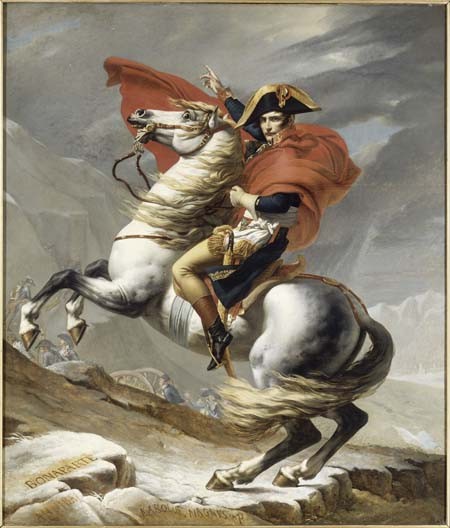The relationship between Napoleon Bonaparte and Jacques-Louis David was tumultuous, but we tend to think rather of the images the latter made of the former, which helped the cause of the general, First Consul then Emperor during fifteen years of power. David started this portrait following the failure of a first monumental portrait which was supposed to commemorate the treaty of Campoformio (18 October, 1797) the famously incomplete version of which remains housed which remains in the Musée du Louvre.
It was ordered by the ambassador of Spain for his master, King Charles IV, who wanted to place a figurative representation of the new hero of Europe in his ‘room of the great captains’ in the Royal Palace in Madrid. The commission, which is not well documented, may have come before the represented events, at the end of 1799 or the beginning of 1800. The painting was completed between September 1800 and January 1801. It commemorates the victorious crossing of the St Bernard pass in May 1800 by the army reserve under the direction of the First Consul Bonaparte, the first stage of his triumphal reconquest of Italy. With great audacity, Bonaparte shocked everyone in crossing the pass reputed to be unnavigable during spring. With this exploit he recalled the great captains of the past, whose names are inscribed on the rock at the horses feet: Hannibal, who crossed the alps with his elephants in 218 during the second Punic war, and Charlemagne in 773, in the struggle against the Lombards. If one believes the legend, Napoleon wished to be represented ‘calmly seated upon a spirited horse’, even though he actually crossed the pass on a mule. What is more, the First Consul did not even pose for the portrait; David worked in his atelier with models, for the outfit, according to tradition, he took inspiration from a uniform borrowed from the First Consul, which he had worn at the battle of Marengo.
The first Spanish version of the composition, later seized by Joseph Bonaparte in Madrid and bequeathed by his descendants to the museum at the Chateau de Malmaison in 1949, was immediately followed by various copies, all destined for prominent buildings: the first for the Chateau de St Cloud, the consular residence, whence it was seized by Blücher in 1815, taken triumphantly to Berlin and given to the King of Prussia, before being placed in a museum in 1816 (it is now at Charlottenburg palace); the second was placed in the Hôtel des Invalides (December 1802), then given to the royal museums in 1816, from where it was sent to Versailles under Louis-Philippe; the next was destined for the Palace of the Italian Republic in Milan (Spring 1803), from where it was transported to Vienna in 1834 before being placed in a museum (Kunsthistorisches Museum, presented in the Belvedere). A final example, probably painted at the beginning of 1803, whose destination remains unknown, remained at David’s atelier and was given by his daughter to the nephews of the Emperor, then acquired by the French State from the Prince Napoleon in 1979 and placed at Versailles. The celebrations of the bicentenary of the epic story of Napoleon fifteen years ago confirmed the iconic status of David’s composition, the archetypal representation of the hero of the Revolution and probably the most famous image of Napoleon in the world.
Frédéric Lacaille, 2013 (tr. AM)


